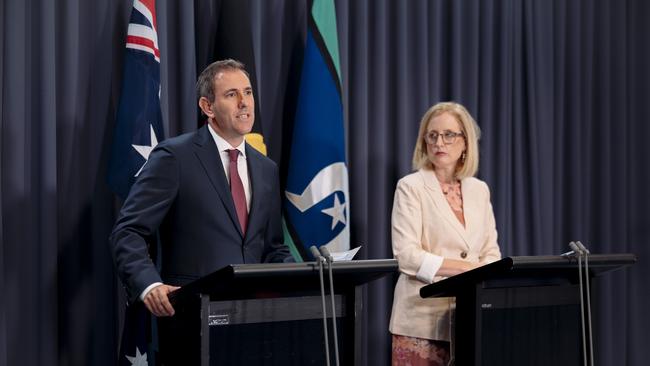
Now the bad news from the future: the size of our economy, crucial to paying down debt, funding services for an ageing nation, and raising our living standards, will be smaller because of a slump in productivity.
And in 10 years, the budget will be even further in the red than previously estimated.
Jim Chalmers declared one of the key parts of his fiscal strategy is that new spending and reforms build the capability of “our people and expand the productive capacity of our economy”.
But drill into the details of the Treasurer’s mid-year report and the economy’s capacity is stuck in the slow lane. Here we’re talking about the famous 3Ps of population, participation and productivity, which ultimately drive our economic performance, following short-run changes in the business cycle.
In Wednesday’s update, Treasury said changes in trends for the 3Ps “have decreased the level of potential GDP over the projections compared with the (May) budget”.
Basically, our economy will be smaller than previously thought.
The May budget papers said potential GDP growth was expected to average 2.5 per cent over the back end of its 10-year projections.
In Labor’s first budget in October last year, Treasury downshifted the 2.75 per cent pre-election estimate for potential GDP growth to 2.5 per cent, mainly reflecting the material change in the long-run productivity growth assumption, from 1.5 per cent to 1.2 per cent.
On the plus side, the level of population (aged over 15) has been revised up by 0.25 per cent on average over the medium term. So that’s an extra 55,000 workers a year due to migration and demography on top of the 325,000 previously expected.
Even though net overseas migration is expected to ease from its record 900,000 over two years, the post-pandemic influx has returned us to the robust population growth trajectory we were on before the crisis.
The trend workforce participation rate is largely unchanged at around two-thirds.
The problem is productivity, that is how much output we’re able to extract from a given level of our precious labour and capital.
“The upgrade in the size of the workforce has been more than offset by a lower estimated level of trend productivity, reflecting continued weak underlying productivity growth, which predated Covid-19 related disruptions that are largely expected to unwind,” Treasury says in the mid-year update.
So the starting point to grow productivity back to trend, and the economy’s capacity, is lower, given the recent backsliding.
Treasury assumes productivity growth soon returns to the two-decade, pre-Covid average of 1.2 per cent. To my mind, that shift is heroic – but it’s the law!
Albanese Labor is betting its human capital, green-energy and competition policy reforms will make that glorious productivity assumption come true. After all, it’s the main driver of higher material living standards, now going backwards, due to higher inflation, interest rates and taxes.
Don’t forget, Australia is getting more expensive to run.
The pandemic era’s splurge and ageing have permanently enlarged Canberra’s footprint; spending and taxing will be 2 per cent of GDP higher, or $50bn in today’s dollars, over the decade.
Productivity growth is fundamental to paying for aged care, the NDIS, defence, health and the interest bill – and to restore buffers for the next crisis.
The dumb luck of super-high coal and iron ore prices and open door to people power can never be a sustainable path to fiscal salvation and national prosperity.







The budget is in “striking distance” of another underlying cash surplus. Rejoice and be glad!